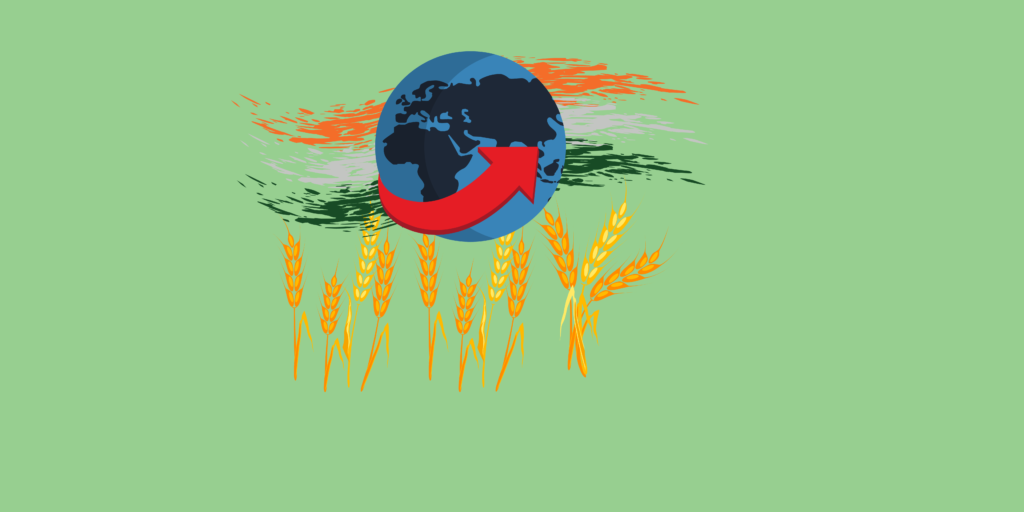
Wheat Economy of India: What is the importance of wheat?
Whether you are aware of it or not, you ingest wheat every day in a variety of foods such crackers, crisp-breads, sauces, confectionary, bread, crumpets, muffins, noodles, pasta, biscuits, cakes, pastries, cereal bars, and sweet and savoury snack foods.
India is the second largest producer of wheat globally. Wheat production of India in the world is around 13.53 percent of world’s total production. India produces around 118.60 MT of wheat annually while a major chunk goes towards domestic consumption.
Let’s study India’s wheat economy. The entire country consumes wheat every day in a variety of ways, but rotis, an Indian flatbread with a circular shape, account for the largest share of consumption. The soluble fibre included in roti is regarded as a wonderful source for lowering blood cholesterol levels, preventing constipation, and maintaining the health of our digestive systems. It is packed with complex carbs, which provide you with long-lasting energy and keep you full for hours. Indians use rots as a basic food on a daily basis, which is why they are always energetic.
The Condition of the Wheat Economy of India in the Past Ten Years.
The table depicts variation in wheat production of top 10 global wheat producers for one decade according to the Food and Agriculture Organisation.
India wheat production rank
Unit: Million Metric Tonnes
In the year 2011, wheat production in india was 86.9 million metric tonnes, then in the year 2012, 94.9 million metric tonnes of wheat was produced which was 8 million metric tonnes more than the previous year, in 2013 93.5 million metric tonnes of wheat was produced with a decrease in the production by 1.4 million metric tonnes within a year.
In 2014, wheat production in India was 94.5million metric tonnes.
Again increasing the production by 1 million metric tonnes
then in 2015,wheat production in India was 86.5million metric tonnes with fall of 8 million metric tonnes in 2016 i.e. the next year the production raised by 7 million metric tonnes and 93.5million metric tonnes of wheat was produced in the following year which was 2017, 98.5million metric tonnes of wheat was produced with an increase of 5 million metric tonnes.
Then in 2018, wheat production in India was 99.7million metric tonnes, increasing the production by 1.2 million metric tonne.
Then in 2019, 103.6million metric tonnes of wheat was produced with an increase of 3.9 million metric tonnes and in 2020, 107.6million metric tonnes of wheat was produced with an increase of 4 million metric tonnes.
According to this data the least quantity of wheat produced for the decade was in 2015 and 2020 was the year where there was the highest amount of wheat production in India.
India’s export of wheat in the last decade.
| MARKET YEAR | EXPORTS | GROWTH RATE |
| 2011 | 0.98 | 1,137.50% |
| 2012 | 7.6 | 665.88% |
| 2013 | 6.68 | -11.30% |
| 2014 | 3.76 | -43.68% |
| 2015 | 1.25 | -66.85% |
| 2016 | 0.55 | -55.66% |
| 2017 | 0.63 | 13.57% |
| 2018 | 0.55 | -12.83% |
| 2019 | 0.56 | 2.62% |
| 2020 | 2.83 | 403.14% |
Unit: Million Metric Tonnes
In the year 2011, the amount of exports were 0.98 million metric tonnes followed by the year 2012, 7.6 million metric tonnes of wheat was exported and in the year 2013, 6.68 million metric tonnes of wheat was exported. Continued by 3.76 million metric tonnes of wheat in 2014 and 1.25, 0.55, 0.63, 0.55, 0.56 and 2.83 million metric tonnes of wheat in the years 2015, 2016, 2017, 2018, 2019 and 2020 respectively.
India’s export of wheat was lowest in the year 2016 and 2018 and highest in 2012.
| Year | Exported wheat | Wheat produced | Percentage of wheat exported out of total wheat produced |
| 2011 | 0.98 | 86.9 | 0.85% |
| 2012 | 7.6 | 94.9 | 7.22% |
| 2013 | 6.68 | 93.5 | 6.25% |
| 2014 | 3.76 | 94.5 | 3.56% |
| 2015 | 1.25 | 86.5 | 1.09% |
| 2016 | 0.55 | 93.5 | 0.51% |
| 2017 | 0.63 | 98.5 | 0.62% |
| 2018 | 0.55 | 99.7 | 0.54% |
| 2019 | 0.56 | 103.6 | 0.58% |
| 2020 | 2.83 | 107.6 | 3.04% |
Unit: Million Metric Tonnes
According to the above table in the year 2011, wheat production in India was 86.9 million metric tonnes out of which 0.98 million metric tonnes of wheat was exported which is 0.85%of total produced wheat for the year 2011 with an increase of 1,137.50% exports in one year.
In the year 2012, 94.9 million metric tonnes of wheat was produced which was a rise of 9 million metric tonnes of increase in the production and 7.6 million metric tonnes was exported which is almost 7.22% of production of the year. And the export rate increased by 665.88% from last year.
In 2013, wheat production in India was 93.5 million metric tonnes and production of wheat decreased by 1.4 million metric tonne and 6.68 million metric tonnes of wheat was exported which is 6.25% of total wheat production for the year and the annual growth rate of exports decreased by 11.30%.
In 2014, 94.5 million metric tonnes of wheat was produced which is 1 million metric tonne less than last year and yet 3.76 million metric tonnes of wheat was exported which is 3.56% of total wheat production for that year with a decrease of 43.68% in growth rate.
In 2015, wheat production in India was 86.5 million metric tonnes, which was 8 million metric tonnes less than previous and 1.25 million metric tonnes wheat was exported which is 1.09% of total wheat production for the year with a -66.85% decrease in growth rate.
In 2016, 93.5 million metric tonnes of wheat was produced with an increase of 7 million metric tonnes of production in wheat and 0.55 million metric tonnes of wheat was exported, which is 0.51% of total wheat production for the year with growth rate of 55.66% of decrease.
In 2017, wheat production in India was 98.5 million metric tonnes which is 5 million metric tonnes less wheat than the previous year hence 0.63 million metric tonnes wheat was exported which is 0.62% of total wheat production for the year and 13.57% increase in growth rate.
In 2018, 99.7 million metric tonnes of wheat was produced which was 1.2 metric million tonnes more than the previous year and yet 0.55 million metric tonnes of wheat was exported which is 0.54% of total wheat production for the year with a decrease of 12.83% of rate of export.
In 2019, wheat production in India was 103.6 million metric tonnes which was 3.9 million metric tonne more wheat than previous year and 0.56 million metric tonnes of wheat was exported which is 0.58%of total wheat production for the year with an increase of 2.62% in growth rate of wheat export.
In 2020, 107.5 million metric tonnes of wheat was produced which was the most production in the decade and an increase of 3.9 million metric tonnes of wheat was produced and 2.83 million metric tonnes of wheat was exported which is 3.04% of total wheat production for the year.
Even Though all of these numbers tell you how the wheat economy worked in our nation for the past decade it is equally true that the consumption of wheat in our home country was taken care of sufficiently even during tough times like covid 19 outbreak and only later was wheat exported from our country.
In 2021, 7.85 million tonnes of wheat was exported out of 108 million metric tonnes surpassing the target of 7 million and indicated robust exports in 2022.
What affected the Wheat Economy of India?
one of the main factors that has an impact on India’s wheat economy. From March to April 2021, Russia commenced a major military build-up near the border, followed by a second build-up between October 2021 to February 2022 in Russia and Belarus. Throughout, the Russian government repeatedly denied it, yet they had plans to attack Ukraine.
In early December 2021, following Russian denials, the US released the intelligence of Russian invasion plans, including satellite photographs showing Russian troops and equipment near the border. The intelligence provided a Russian list of significant sites & individuals to be murdered or neutralized. The US published numerous reports that predicted the invasion strategy with accuracy.
How did the Russia and Ukraine’s war affect the wheat economy of india?
Before the invasion, food prices were increasing due to reasons including harsh weather and poor harvests that reduced supplies and sharply increased global demand following the COVID-19 pandemic.
90% of the wheat and other grains harvested in Ukraine are transported to international markets by sea, but this process has been slowed down by Russian blockades along the Black Sea coast. The amount of grain being diverted across Europe through rail, road, and river is negligible in comparison to marine routes. Because Ukraine’s rail gauges don’t match those of its neighbours, the shipments are also delayed.
Anna Nagurney, who studies crisis management at the University of Massachusetts, Amherst and is on the board of the Kyiv School of Economics says 400 million people worldwide rely on Ukrainian food supplies. The U.N. The Food and Agriculture Organisation predicts that up to 181 million people in 41 countries could face a food crisis or worse levels of hunger this year.
How did Prime Minister Narendra Modi come into the picture?
Prime Minister Narendra Modi on 12th April 2022 during his talk with US President Joe Biden, offered to supply India’s food stock to the world if the World Trade Organisation (WTO) accords permission.
After opening the dormitory and educational complex of Shree Annapurna Dham Trust in Adalaj, Gujarat, via video link, Modi declared that the war in Ukraine is depleting food supplies in other regions of the world.
“India already has sufficient food for its citizens, but it appears that our farmers have made plans to feed the entire world. However, we have to work according to the laws of the world, so I don’t know whether the World Trade Organization will give permission and we can supply food to the world,” Modi said.
Heat waves affect the wheat economy.
A heat wave occurs when an area’s highest temperature exceeds 40 degrees Celsius or when the average temperature increases by 5 degrees Celsius.
Now you must be thinking what has a heat wave got to do with the wheat economy and its exports?
On 13th April 2022, that is the right next day after our pm announcement of feeding the world, India Meteorological Department announced the possibilities of heat waves and it started affecting immediately. An unusually early record-shattering heat wave in India reduced wheat yields, raising questions about how the country will balance its domestic needs with ambitions to increase exports and make up for shortfalls due to Russia’s war in Ukraine. India saw a heat wave stretch this year which started in March. It lasted from March 11 to 19; March 27 to April 12; April 17 to 19 and April 26 to 30. In April, several parts of northwest India recorded temperatures above 45°C spiking to over 47°C.
Wheat crisis in India makes Prime Minister Narendra Modi take his words back. It has an impact on the Wheat Export Ban.
Around 14 stations in different parts of the country broke temperature records in April. Due to rising temperatures in the southern part of the country many paddy fields caught fire turning them to ashes and spilling water on the dream of feeding the world causing wheat crises in India. Further it came to notice that many countries have been stocking on food grains etc. due to the uncertainties of future trade therefore PM Modi banned India’s export of wheat. Will it have an impact on economic diplomacy?
The wheat was banned from being exported to make sure that there would be enough food for domestic use and the people of India could be fed well even during the time of uncertainties.




